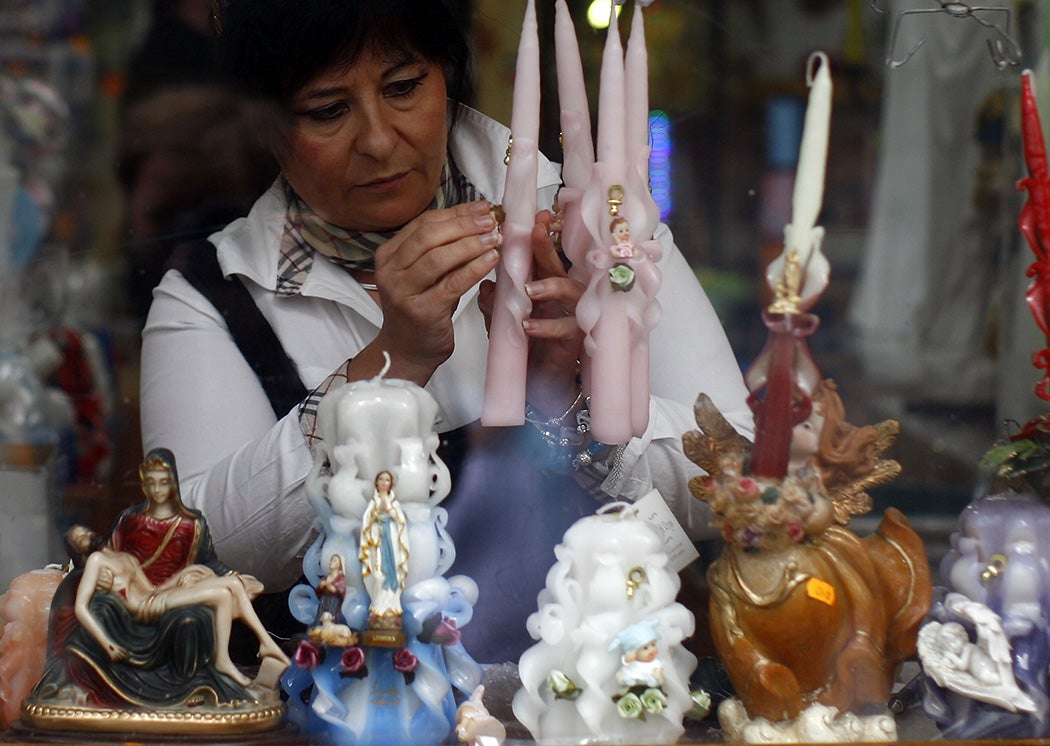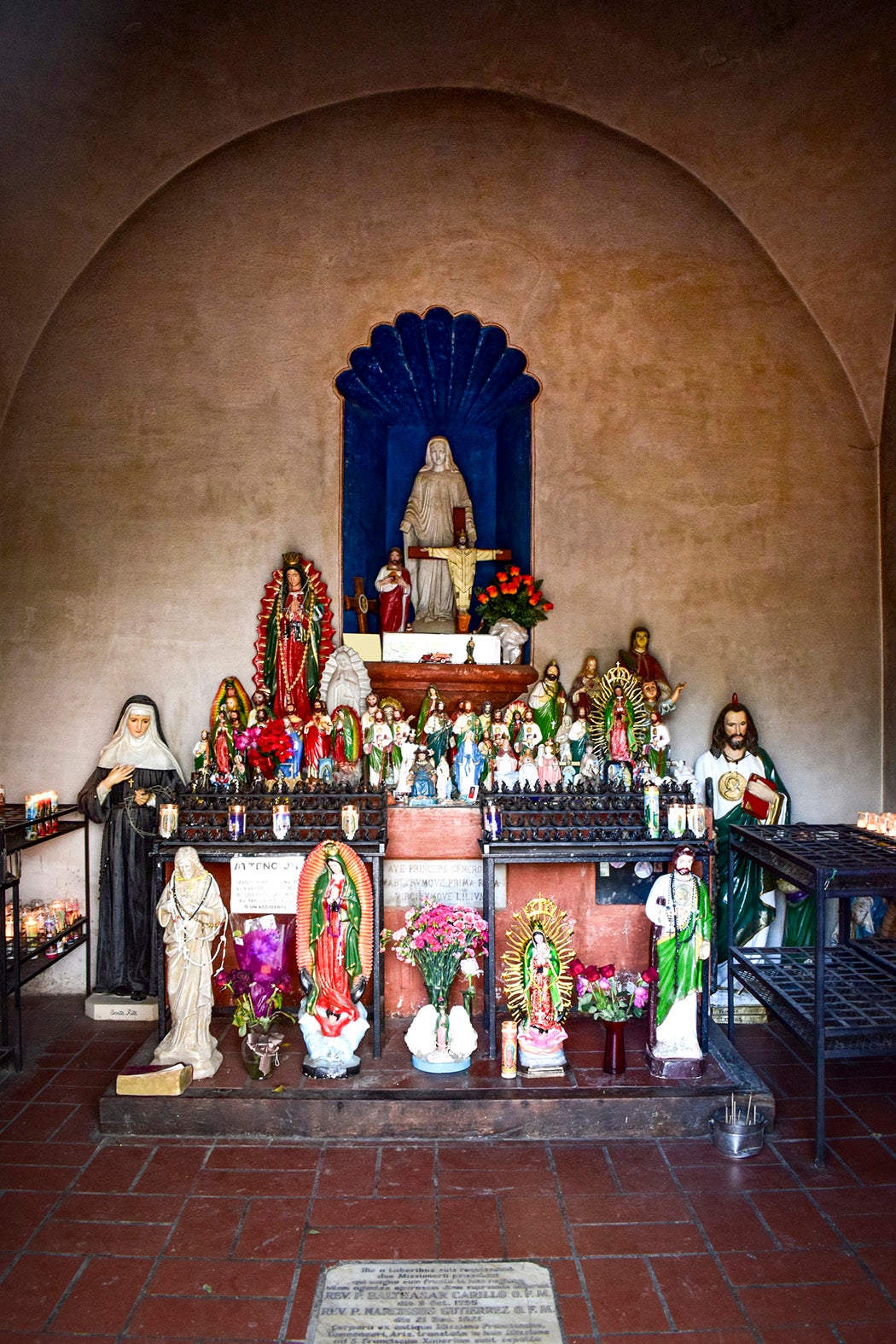Past the severe façade of the Martin E. Thompson Bank of the United States, an early nineteenth-century structure transplanted into the Metropolitan Museum of Art, there are dozens of galleries devoted to American art. A variety of early American design styles, from the colonial to the federal, are presented. The great furniture makers of Philadelphia and Newport have their work displayed. The pewters of Paul Revere are exhibited, as are the colorful glass lamps of Louis Comfort Tiffany. These collections of American arts and crafts—ceramics, pewters, jewelry, sculpture, painting, furniture—fill the exhibition space, spread across twenty “period rooms,” ranging from an eighteenth-century Dutch-style Albany mansion parlor to a strikingly modern room designed by Frank Lloyd Wright. Toward the back of the American wing, in Gallery 734, there is a set of furniture that bridges the aesthetic of the colonial and the modern, including chairs, desks, benches, and tables built by hand by a community of Shakers from New Lebanon, New York, in the middle of the nineteenth century.
Born from the already non-conformist Quaker Society of Friends, the Shakers were a sect of radical religious dissenters who preached pacifism, celibacy, and the imminent millennium. True to their iconoclastic Reformation roots, the Shakers believed that nothing should be extraneous, and they became celebrated for constructing exceptional furniture of pure utility. They avoided decoration anything frivolous or complicated. Shaker furniture’s reputation is for clean lines, rectilinearity, and minimalism. An inattentive museum-goer who wanders into the Shaker Gallery could easily assume that the furniture was made far more recently—it evokes the Mid-century modern aesthetic just as well.
Weekly Newsletter
As Stephen Bowe and Peter Richmond noted in their 2006 book Selling Shaker: The Commodification of Shaker Design in the Twentieth Century, members of the religious sect “were probably the first to work in a ‘Modernist’ aesthetic.” The Shakers, true to their Quaker roots, relied on the insights of an individualized “inner light” that rejected anything wasteful or prideful. Their simple but sturdily made furniture was true to a practical theology. Such an ethos is not dissimilar to the same aesthetic seen in secular design from the twentieth-century, ranging from the Dutch De Stijl movement to the German Bauhaus.
The writer Marguerite F. Melcher argued in the Philadelphia Museum of Art Bulletin that the reason for the “interest in Shaker products is its functionalism.” She claimed that in the “simplicity of line,” and the principle that there should be “nothing for show, everything for purpose,” the entire history of modern design “owes something to the Shakers.”
Several rooms over, a very different décor can be found in the Wrightsman Galleries for French Decorative Arts. In gallery 525, museum-goers can view the intricate carved and painted boiserie, or wood-paneling, from the eighteenth-century Parisian residence known as the Hôtel de Varengeville. Across the glowing, gilded surface of the paneling are depictions of flowers and shells. Golden-framed mirrors line the walls. An oak writing table is decorated with lush golden-gilded embellishment, one overstuffed upholstered chair sits behind it and another is next to it, and all are atop a rug woven in hues of yellow and blue. Heavy golden candelabras and candle-sticks sit on a marble fireplace and several side tables. Hanging from the ceiling of the gallery is a chandelier, an exploding spectrum of light reflected off of its multitude of shimmering, shaking slivers of glass.
If the Shaker gallery expressed an aesthetic of sobriety, simplicity, and stolidness, then the galleries of French rococo are lush, luxurious, and almost lurid. Shaker furniture is minimalist, while the Hôtel de Varengeville is almost defiantly maximalist; the Shakers emphasized practicality and utility, while the French artisans of the previous century celebrated artifice, decoration, and detail. One is simple, the other is complicated; the former is modest, the latter is opulent; the first is humble, the second is lavish.
If, as Daniel T. Jenkins says in Literature and Theology, Protestant art takes as its injunction “not to think more highly of ourselves than we ought to think,” then the rococo decoration of Gallery 525 is consummately non-Protestant art. Not incidentally, rococo is an aesthetic that, although it would ultimately be embraced throughout the West, finds its origins in Catholic culture. It is also, a museum-goer might be forgiven for thinking, decoration that fundamentally looks and feels as if it is kitsch.
* * *
Kitsch is a conflicted term—hard to strictly define, but as with Supreme Court Justice Potter Stewart’s joke about pornography, one knows it when one sees it. Borrowed from a nineteenth-century German word for cheaply-made, disposable versions of fine art pieces, “kitsch” denotes an accidental style or mode that often connotes tackiness and provincial tastelessness. When the term is used, it calls to mind the heavily gilded porcelain of a Hummel figurine, the garishness of a velvet painting of the Virgin Mary or Elvis, the luminescence of a Thomas Kinkade landscape. Kitsch is cousin to camp, but lacks the self-awareness of the latter. Kitsch is colorful, flamboyant, crowded, gilded, and golden. Concerning taste, kitsch expresses the exact opposite of the simplicity of the Shaker furniture; it’s the antithesis of what Bowe and Richmond describe as the “tendency towards the increasingly fashionable notion of minimalism.”
For the purchasers of kitsch in nineteenth-century Munich, reproductions of elaborate and intricate decoration were a means of class ascension. But they also signaled a type of bourgeoisie cluelessness concerning taste, discretion, and style. Something can look expensive; indeed, something can be very expensive, and still be kitsch—maybe all the more so because of it. Less a strictly delineated style or movement, kitsch is a sort of naïve attitude or approach to art, one that, to paraphrase the German modernist critic Hermann Broch, seeks to promote the beautiful without any concern for the good.

Largely limited to German art criticism until the twentieth-century, it was critic Clement Greenberg who popularized the word kitsch in his 1939 Partisan Review piece “Avant-Garde and Kitsch.” He argued that kitsch is a “simulacra of genuine culture,” that it is “mechanical and operates by formulas… the epitome of all that is spurious in the life of our times.” T. J. Clark explains in Critical Inquiry that Greenberg saw kitsch as a “sign of a bourgeoisie contriving to list its identity… an art and a culture of instant assimilation… of avoidance of difficulty, pretense to indifference, equality before the image of capital.” In this view, kitsch is an attempt at purchasing a type of aesthetic experience, the commodification of art with indifference to quality or discernment, which subsequently devalues the idea of art overall.
The last point is crucial, for Greenberg sees kitsch, which he says emerges from the Industrial Revolution, as the direct product of a capitalist commodification that cares nothing for aesthetics beyond profit. Strictly speaking, then, although the Hôtel de Varengeville’s ostentatious furniture, excessive gilding, and ridiculous displays of wealth are all evocative of kitsch, they aren’t, by Greenberg’s estimation, kitsch proper.
The Hôtel de Varengeville is the product of eighteenth-century French aristocratic culture and not of industrial capitalism, hence it is not kitsch. Were somebody to finish their suburban basement so that it looked like the drawing room from the Hôtel de Varengeville, that would be kitsch. Still, it’s hard not to see Greenberg’s (strongly Marxist) reading of kitsch’s aesthetics as limited in some way, for all of the attributes we associate with it—the gold, the busyness, the ornateness—can be traced back to movements, from the rococo to the Baroque, that pre-date modern capitalism.
More than an issue of pure aesthetics, kitsch can’t be disentangled from society, culture, and economics, even while we tend to conflate it with garish maximalism. As a display of elegance, ownership of a Shaker chair (or of an IKEA version made to resemble it) is presumably intended to demonstrate certain qualities in the person who possess it. These include values such as propriety, humility, and understated sophistication, all of which Anglo-American class politics has associated with a certain aesthetic minimalism. By contrast, the colorful, shining, gilded surfaces of a rococo mirror or an overstuffed couch seem undeniably kitschy. It’s worth asking why we make this distinction – especially when considering how so much of what we think of as kitsch draws from the pre-modern period.
The literary scholar Călin-Andrei Mihăilescu notes in The Comparatist that “[w]e realize intuitively that the theory of kitsch as exclusively (post) romantic is too limited.” Somebody who anachronistically conceives of Shaker furniture from antebellum America as echoing “the tenets of European modernism,” as William D. Moore writes in Winterthur Portfolio, shouldn’t have issue with tracing a genealogy of kitsch, at least in its basic visual idiom, as going back earlier than has often been surmised. If one removes oneself from the totalizing realm of economics implied by capitalism, one is forced to confront the role that theology plays in aesthetics. If one must divinize the minimalism of the Shakers, perhaps one can do something equivalent with kitsch. As the theology scholar Nathan D. Mitchell writes in The Mystery of the Rosary:
There are, then, fundamental aspects of Catholic belief that can be understood only through… the aesthetic sensibility of kitsch.
To say so is to make no value judgement about the qualities of kitsch. In fact, it’s to do the opposite. It’s to ask if there isn’t some social and sectarian bias that colors why we so often identify and illustrate kitsch in the manner that we do.
Whether or not we can strictly define the decorations of the Hôtel de Varengeville as kitsch or not is one thing, but that we so readily can admit that it reminds us of kitsch is another. There is, I would argue, an unspoken set of theological-aesthetic commitments that have prejudiced the Anglo-American public into interpreting that which can be read as “Catholic” (or “ethnic”) as kitsch, and that which is Protestant—with its clean lines and unadornment—as the paragon of sensible good taste.
When Mihăilescu imagines a typical tableau of contemporary American kitsch, he describes gardens “adorned with little white Popes and Kennedys surrounded by light bulbs, leading up to steps guarded by two gypsum lions.” Consider just how Catholic this invented display is. Whether or not kitschy art is good or bad, we’ve been conditioned to see it as low value precisely because it calls to mind the busy, frantic, colorful conventions of traditional Catholic art, whether the busy murals of a Titian or the pyrotechnics of Hispanic Catholic folk culture. When kitsch is attacked based on aesthetic rather than commercial grounds, what’s critiqued, implicitly, is a certain set of Catholic theological pronouncements—and, more perniciously, those who hold faith in those pronouncements.
Christopher Chowrimootoo writes in Middlebrow Modernism: Britten’s Operas and the Great Divide that the denigration of kitsch was born out of Protestant “opposition to ritualism and aestheticism, practices heavily associated with the Roman liturgy.” Shaker design was born from their religious principles, what Daniel T. Jenkins described as a Protestant aesthetic of “simplicity, sobriety, and measure.”
Protestantism, with its commitment to scripture alone, and its iconoclastic rejection of ritual, liturgy, and relics, often encouraged a certain artistic minimalism (though not always). Catholicism, on the other hand, with its commitments to a sacramental understanding of existence, one that is more apt to see divinity as permeating profane reality, has more room for materiality, physicality, and sensuality in representational art.

Aesthetic attacks on kitsch are not just statements against Catholic theology (implicit or explicit, conscious or unconscious), but also, in some sense, attacks on Catholic believers themselves. If the discourses of discernment that mock, belittle, and judge kitsch can be seen as denigrating certain aspects of Catholic theology, they must also be read alongside histories of racial and ethnic marginalization. So often, the examples that are given of kitsch, from the “Mary on the Half-Shell” displays popular in northeast American working-class neighborhoods, to reproductions of fine art masterpieces, from the Pietà to The Last Supper, are clearly Catholic.
Implicit in such attacks are beliefs that these works lack the refined taste or simplicity of a Shaker chair, that they’re just too ethnic. Such critiques can be seen as not just anti-Catholic, but in some sense anti-Irish, anti-Italian, anti-Hispanic, and so on. The last category gives us an extra layer of nuance, since if one reads so much of the genealogy of kitsch backwards into the baroque, then one must also acknowledge how much of the baroque is owed to colonial American sources. Lois Parkinson Zamora argues in PMLA that the baroque’s “visual and verbal forms [that] are ample, dynamic, porous, and permeable” draw as much from European antecedents as they do American Indian and African influences. She writes that the baroque depends on the incorporation of “cultural perspectives and iconographies of the indigenous and African laborers and artisans who built and decorated Catholic structures.” The “baroque itself,” she concludes, “was eventually colonized.”
In making a space for that which has been called “kitsch,” given the sociocultural reasons for why certain aesthetics are embraced, there is an ethical defense of the form. The denigration of kitsch betrays an anti-Catholicism born from centuries of class and ethnic divisions, and in embracing kitsch we overturn some of that bias. But there are also theological, and thus aesthetic, defenses of kitsch that can then be made as well.
Mihăilescu writes that kitsch “is made possible, and later necessary, by the lowering of theology… by artistic means.” This statement is meant as a compliment. In looking for an artistic mode that expresses immanence—the permeating of the sacred throughout the profane world—there are few aesthetics more suitable than kitsch. Read uncharitably, kitsch is misinterpreted as being about a bourgeois purchase of luxury at discount rates. But it could equally be read as the democratizing of transcendence. No longer is The Last Supper preserved on a Milanese wall. It can exist in velvet, in a kitchen. The Pietà doesn’t have to stay in St. Peter’s Basilica. It can now be illuminated in neon on someone’s bookshelf. Mihăilescu says that such art is meant to “mediate between the world and the sacramental state. The image stands on the border between ritual and the profane, as the priest dwells on the border between human and divine.”
Think of the muscly sinew on a nude torso as painted by Caravaggio, the orgasmic ecstasy sculpted by Bernini, or the queer beauty depicted by Michelangelo—all aglow with a type of immanence. Displays of passion, emotion, and intensity are the hallmarks of Catholic Renaissance and Baroque art. They also are on ample display in art that’s considered kitsch, diametrically opposite the disinterested rationality of a Shaker desk or chair. Chowrimootoo writes:
…such aestheticism was often still coded as ‘Catholic’ in the most derogatory senses of the term. For some Evangelicals, high liturgy signaled moral depravity and sensual indulgence.
We’ve carried those same sentiments over into secular art criticism, in our definitions of taste and class. But it’s time to reclaim kitsch.
Kitsch should be understood not as lack of taste, but as the declaration of ownership over sacred things by the mass of humanity. A Shaker chair states certain beautiful things about God—simplicity, parsimony, elegance, silence. But kitsch can say something about God as well—glory, complexity, color, grandeur.







